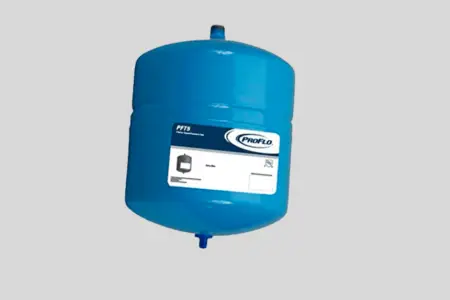As plumbing systems evolve, expansion tanks have become fairly standard on most houses. Expansion tanks are necessary to protect water heaters and water pipes within a plumbing system due to expansion caused by hot water. An extremely important part of maintaining your expansion tank is checking the pressure.
To check your expansion tank pressure, you should use a standard tire gauge and press it against the valve on the top of the tank. You can then adjust the pressure with a hand pump and raise the pressure as needed. If pressure is too high, simply press against the Schraeder valve to release air inside the tank.
In this article, we’ll go into more detail about how to check and adjust the pressure of your expansion tank. We’ll also discuss what to do if the pressure is too low or high and what happens when your tank fails.
Expansion tank pressure calculation
Most expansion tank manufacturers state that their tanks are precharged to 12 psi, but this isn’t always correct. You should always double-check the pressure of the tank to make sure. Plus, 12 psi isn’t always the right setting that your tank should be at. Depending on the height of your water pipes, you may need a psi higher or lower than 12. The goal is to have the charge of the expansion tank match that of the water pressure inside the building.
The formula for expansion tank pressure calculation is: Pa = H(Dc / 144) + 5.
Pa = air-side pressurization of the tank (psi)
H = distance from inlet of expansion tank to top of the system. (ft.) Simply put, measure the distance from where the expansion tank connects to the plumbing system to the highest pipe in the plumbing system.
Dc = density of the fluid at its initial (cold) temperature (lb./ft.3)
5 = assumed five psi at the top of the system (you can change this to other values)
144 = the units conversion constant
At a typical cold fill temperature of 60º F, water has a density of 62.4 lb./ft.3. A 40% solution of propylene glycol antifreeze thickness is 64.90 lb./ft.3 at 60º. Look up their density at the expected cold fill temperature for other fluids.
This formula is used to calculate the water pressure of the house, which is what you should adjust the expansion tank pressure to. If you have a water pressure regulator installed in your plumbing system, you can also check its reading and adjust accordingly.
How to check expansion tank pressure
Checking the expansion tank pressure is relatively simple, and here’s how you do it.
- At the top of the expansion tank, there’s a plastic cap. This cap is usually black or blue and is flush with the expansion tank.
- Remove the air inlet valve cap to access the Schraeder valve beneath.
- Use a standard tire pressure gauge to check the pressure the same way you would check a tire’s pressure.
- Once you know the pressure of the expansion tank, you can adjust it accordingly by adding or removing air.
- Every time you add or subtract air, make sure to double-check the pressure with your gauge.
- Once you’re satisfied with the air pressure, replace the protective cap on the air inlet valve.
This is the procedure for checking the pre-charge of the expansion tank before you install it. However, you should also check the pressure of the tank once a year to make sure that the charge is being maintained. Here’s how to do that.
- Turn off the main water supply to the house or building.
- Go to a faucet and open it up on the hot and cold sides to ensure that there’s no water left in the lines or expansion tank. This relieves the system pressure so that you’ll only calculate the air pressure within the expansion tank.
- Follow steps 1-6 listed above to check, adjust, recheck, and finalize the expansion tank pressure check.
What happens if the expansion tank pressure is too low?
The whole point of checking the pressure of the expansion tank is so that you can adjust it accordingly. If the pressure is too low, you’ll need to add pressure to the tank. Here’s how you add pressure to an expansion tank.
- Remove the protective cap on the air inlet valve to access the Schraeder valve underneath.
- Before you checked the air pressure of the expansion tank, you should have emptied the tank of water.
- With the tank empty and the pressure calculated, add air to the tank until it equals the house’s water pressure.
- Use a hand pump to add air to the expansion tank so that you have control over how much you’re adding.
- Adding too much air too quickly can rupture the bladder, so make sure to use a hand pump or tiny compressor.
What about when expansion tank pressure is too high?
If the pressure is too high, you’ll have to remove air from within the expansion tank. To do that, follow steps 1-3 listed above, but instead of adding air, you want to remove air. Simply press down on the Schraeder valve to release air until you hear air hiss out. Continue removing air until the tank’s pressure matches the water pressure of the home.
What happens when an expansion tank fails
Because the job of an expansion tank is to protect your plumbing system from excess pressure, it’s pretty obvious when the expansion tank fails. One of the possible outcomes of a failed expansion tank is that it will explode. This happens because too much pressure is filling the tank and not properly releasing it, which means the pressure has nowhere to go but boom.
Other signs of expansion tank failure are condensation on the outside of the tank, damage to your water heater, or damage to your plumbing pipes and valves. It’s essential to check your expansion tank regularly for any signs of failure and contact a plumbing professional accordingly.
Final Thoughts
Expansion tanks are extremely important components within your plumbing system, and they are often required by code. As such, you must know how to test and check your expansion tank for signs of trouble. Failing to check and adjust the air pressure inside the tank is one of the most common reasons for expansion tank failure. Now that you know how to do this, your tank should protect you and your plumbing system for years to come.

Nick Lopresti is the founder of YourH2Home and a home improvement expert. He has years of experience writing about various home improvement topics, mostly as it pertains to water systems.
